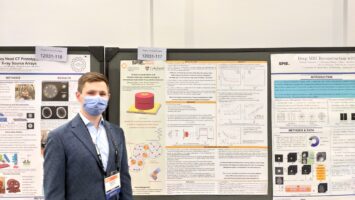Date: August 4, 2022

Congratulations Tristan and co-authors on your published paper in the Sensors Special
Issue Advanced Materials and Technologies for Radiation Detectors. Tristian’s paper is titled
“Dark Current Modeling for a Polyimide—Amorphous Lead Oxide-Based Direct Conversion X-
ray Detector”.
Abstract
The reduction of the dark current (DC) to a tolerable level in amorphous selenium (a-Se) X-ray
photoconductors was one of the key factors that led to the successful commercialization of a-Se-
based direct conversion flat panel X-ray imagers (FPXIs) and their widespread clinical use. Here,
we discuss the origin of DC in another X-ray photoconductive structure that utilizes amorphous
lead oxide (a-PbO) as an X-ray-to-charge transducer and polyimide (PI) as a blocking layer. The
transient DC in a PI/a-PbO detector is measured at different applied electric fields (5–20 V/μm).
The experimental results are used to develop a theoretical model describing the electric field-
dependent transient behavior of DC. The results of the DC kinetics modeling show that the DC,
shortly after the bias application, is primarily controlled by the injection of holes from the
positively biased electrode and gradually decays with time to a steady-state value. DC decays by
the overarching mechanism of an electric field redistribution, caused by the accumulation of
trapped holes in deep localized states within the bulk of PI. Thermal generation and subsequent
multiple-trapping (MT) controlled transport of holes within the a-PbO layer governs the steady-
state value at all the applied fields investigated here, except for the largest applied field of 20 V/μm.
This suggests that a thicker layer of PI would be more optimal to suppress DC in the PI/a-
PbO detector presented here. The model can be used to find an approximate optimal thickness of
PI for future iterations of PI/a-PbO detectors without the need for time and labor-intensive
experimental trial and error. In addition, we show that accounting for the field-induced charge
carrier release from traps, enhanced by charge hopping transitions between the traps, yields an
excellent fit between the experimental and simulated results, thus, clarifying the dynamic process
of reaching a steady-state occupancy level of the deep localized states in the PI. Practically, the
electric field redistribution causes the internal field to increase in magnitude in the a-PbO layer,
thus improving charge collection efficiency and temporal performance over time, as confirmed
by experimental results. The electric field redistribution can be implemented as a warm-up time
for a-PbO-based detectors.
Continue reading the article: https://doi.org/10.3390/s22155829





